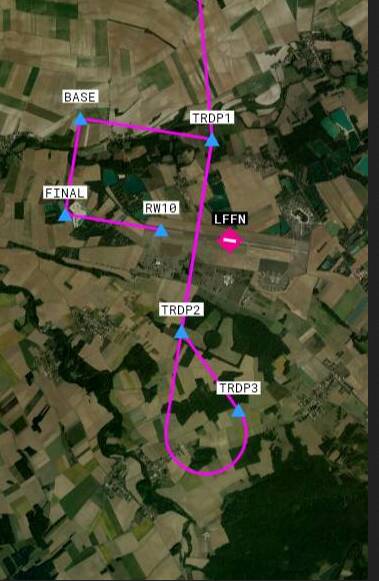MSFS2024 seems to be advocating a reverse teardrop for a north arrival to LFFN, RW10. comprising of a course reversal at pattern + 500’ to arrive back at ‘PATTERN ALTITUDE’ at TRDP1 where you join the downwind traffic at 45 deg, yeilding to existing traffic. My question is, if a yeild is required where do you fly? I dont see anywhere safe to go. It seems to me that haven done the course reversal one should recross the airfield at pattern + 500’ and execute a 2nd teardrop as if you had flown from the south. I was unable to find any reference to a reverse teardrop on the web.
That teardrop would be appropriate for a right-hand traffic pattern to runway 10 coming from the “dead” side of the pattern (north). Left traffic is standard in the real world, but you’ll find many runways (in the US at least) use right traffic for various reasons. I doubt that’s the case here.
Either way, as far as I’m aware, all sim runways are defaulted to left traffic, but can be designated as right traffic in the SDK if needed. However, most runways that do have right traffic are still designated as left in the sim (the database did not take), and the ones I’ve changed correctly to right traffic in the World Hub still don’t seem to implement it (the EFB often still plots left traffic despite that setting).
The only time you’d ever want to consider doing a double back like this is if it’s a really unknown runway condition, maybe a soft runway and/or a low-use airport. But even then, coming from the live side of the pattern, it’d be better to do a normal pattern and a low pass along the runway, then around again.
That’s a long way to say I don’t know why it’s trying to inject a right pattern entry here. Do a
45° entry to a left downwind. You can change the pattern entry in the EFB prior to flight and “file with ATC” to change it in the sim.
following up on your ‘live side’ reference, I now see what I should be doing is a ‘Standard Overhead Join’, a look up on this resolved my yeild concern. The reverse teardrop looks like a msfs invention?
It’s less of an invention and more of a bug in the planner as it’s recommending the teardrop on the wrong side.
Let’s say you were coming from the south and joining a proper left pattern on the north side of runway 10. In the US, there are two acceptable methods - the overhead direct downwind join (which is standard in Canada and I believe the UK and many other places), and the teardrop which would have you overfly the airport, fly two miles beyond the pattern, then execute a teardrop to the northeast to join the downwind at a 45° angle.
Here are three valid ways to make an entry to a circuit/pattern at a non-towered/uncontrolled airport configured like this (assuming anywhere in the world):
Blue is a 45 entry to the downwind from the live side (north) of the pattern - what it should have had you do.
Red is a overhead direct downwind entry from the dead side (south), which is standard in most countries, and can be done in the US if traffic allows
Magenta is the overhead teardrop to a 45, which is common in the US and not common in most other countries
Note that there are other possible pattern entries, especially at towered airports.
I see looping from NE onto the blue makes sense. It doesnt have you fly over rw but I assume dw observation is good enough.
Yes and no - kind of depends on the airfield.
There are a lot of moderately to heavily used nontowered GA airfields in the US at which I’d have no qualms about entering the pattern and landing without an overflight (and yeah, you can usually get a decent idea on downwind). Consider that if there are five aircraft beating up the circuit doing touch and go’s, you probably don’t need to do an inspection pass.
It’s the private strips, the soft runways, and the very lightly used airports, especially after rough weather (or winter in general) where that becomes more problematic. There’s also the issue of deer and coyotes at some airports, especially from dusk to dawn.
Regardless, I wouldn’t say it’s a bad idea to do an overflight, but it’ll be argued by some that it’s unnecessary and inefficient, and frankly, heavy traffic at some airports makes that difficult, possibly even unsafe.

